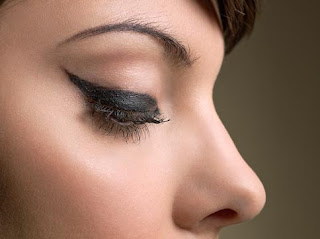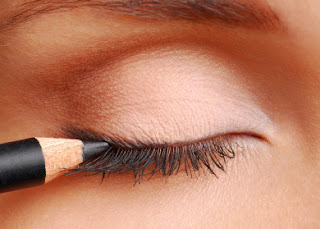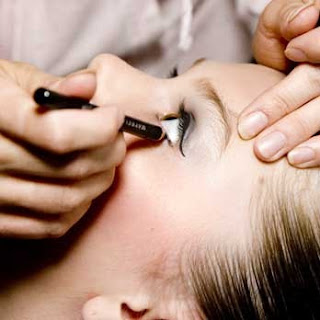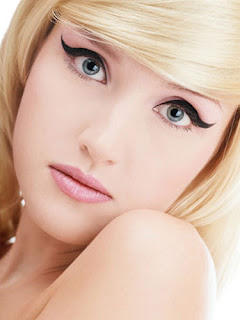Assuming you have a steady hand (if not, try this sitting down so you can steady your arm by placing your elbow on a table), position your brush, pencil, or applicator so it is as close to the lash-line along the eyelid as possible. Then draw a line from the inner to outer corner using one fluid stroke, following the curvature of the eyelid. Do not extend the line past the outer corner of the eye or hug the tear-drop area of the eye. To start, keep the line as thin as possible, and if a thicker line is desired, repeat the process either across the entire lash-line or simply on the outer third of the lid along the lashes. Making the line along the eyelid a solid, even one, starting thin at the front third of the lid and becoming slightly thicker at the back third of the lid can be an attractive classic look.
You can line all the way across the eyelid if you like, from the inside corner to the outer edge, or you can stop the line where the lashes stop and start. Along the lower lashes, line only the outer two-thirds of the eye. Be sure the lower liner is a less-intense color than the upper liner. Also make sure that the two lines meet at the back corner of the eye. As a general rule, avoid lining all the way across the lower eyelashes. Leaving some space on the inside corner of the eye where the lashes end near the tear ducts gives a softer, less severe look. Plus, wrapping a complete circle of eyeliner around the eye tends to create an eyeglasses look and can make the eyeliner a stronger statement than the eye itself.
How thickly can you line the eye? As a general rule, for a classic look, the thickness and intensity of the eyeliner is determined by the size of the lid—the larger the eyelid area, the thicker and softer the eyeliner should be. The smaller the eyelid area, the thinner and more intense the liner should be. If your lid doesn’t show at all, forget lining altogether.
What about applying eyeliner in the rim of the eye? There are many reasons why this is not a good idea. The first is that this kind of application smears in a very short period of time and creates goopy dark specks in the eye. Applying any makeup that is destined to smear in less than an hour or two is not a good idea. Pencil applied along the rim of the eye usually causes the area to become irritated; after all you are putting a foreign substance next to the mucous membrane of your eye. I am equally concerned about the health of the eye area when this technique is used. While there are no studies indicating there are any risks associated with pencil being applied to the rim of the eye, it seems problematic to put cosmetic ingredients (that include coloring agents and preservatives) that close to the eye.
Which eyeliner color should you use? For a classic eyeliner application, choose shades of dark brown, gray, or black eyeshadow for the upper lid and a softer shade of those—tan, taupe, chestnut, soft brown, soft gray, or soft black—along the lower lashes. Eyeliner is meant to give depth to the lashes and make them appear thicker. If the liner is a bright color or a true pastel, attention will be focused past the lashes to the colored line, as opposed to the more subtle flow of color from dark lashes to dark liner. Test it on yourself. Line one eye with a vibrant color, the other eye with brown or black, and see which one looks like it has thicker lashes. Then, if all my attempts to convince you have failed, and you still prefer to use bright or pastel liners, go for it.
Checking for Mistakes
After using powder eyeshadow as eyeliner, check for drippies under the eye and on the cheek. Drippies are those little powder flakes that fly off the brush and land on the cheek. Knocking off the excess from the brush every time helps prevent drippies, but there will always be flakes that end up where they don’t belong. The best way to go after drippies is to use your sponge and simply wipe them away. If you do this, your next step is to touch up your foundation if that has gotten smeared. Always double-check the intensity of your eyeliner application and blend away any thickness or color that is more dramatic than you intended. If you do choose to wear pencil eyeliner, check for smears under the eye as the day goes by. This is annoying, but letting it go without blending away the smears can make any well-applied, eye-makeup design look like a mess.
Eyeliner Mistakes to Avoid
Do not use greasy or slick pencils to line the lower lashes; they smear and smudge.
Do not use brightly colored pencils or eyeshadows to line the eye; they are distracting and automatically look like too much makeup. All you’ll see is the color and not your eye.
Do not extend the eyeliner beyond the corner of the eye (no wings).
Do not make the eyeliner the most obvious part of the eye-makeup design.
Do not line the inside rim of the lids, between the lash and the eye itself; it is messy and can be unhealthy for the cornea.
If you do use pencil to line the eye, apply a small amount of eyeshadow over your pencil eyeliner to help set it and keep it from smearing.
Do not apply thick eyeliner to small or close-set eyes.
Do not use eyeshadow as eyeliner unless you use the proper brush (one with a small, precise, fine-tipped point).
Do not line the eye with a circle of dark or bright color. Both are too obvious and create an eyeglass-style circle around the eye.
Do not overblend, spilling your eyeliner onto the skin under the lower lashes; that makes dark circles look worse.





No comments:
Post a Comment